What a great bird banding season at Barr Lake State Park! It seems like only yesterday that bird bander Meredith McBurney and I kicked off the season in August, banding 50 birds with only four of our 21 nets open. In retrospect, this proved to be an omen of the sensational fall migration that was to come.
This season, we banded over 1,700 birds. We also caught 14 birds that were banded by RMBO in prior years. Wonderful data like this will provide us with insight into the lifespan of migratory birds, as well as their site-fidelity during migration. With a diversity of 71 species, including the Bay-breasted Warbler that had never been banded at this station before, it was a “big year” for the Barr Lake Banding Station. We had not reached numbers at this level and at this location since 2006!
The list of rare – and relatively rare – species caught this fall includes:
- Red-naped Sapsucker
- Philadelphia Vireo
- Golden-crowned Kinglet
- Veery
- Tennessee Warbler
- Northern Parula
- Nashville Warbler
- Magnolia Warbler
- Western Palm Warbler
- American Redstart
- Field Sparrow
- Swamp Sparrow
- White-throated Sparrow
- Winter Wren
- Rose-breasted Grosbeak
Oh, and I almost forgot to mention three Sharp-shinned Hawks!
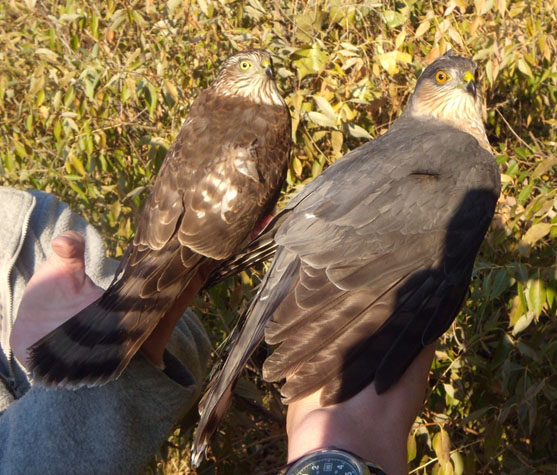
The perfect ending to an amazing banding season: adult (right) and juvenile (left) Sharp-shinned Hawks caught on our very last day of the banding season at Barr Lake State Park.
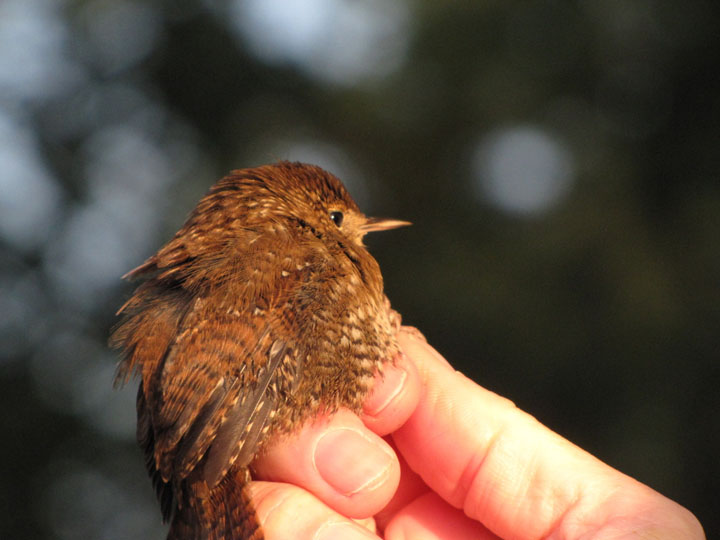
A rare glimpse of a Winter Wren at the Barr Lake Banding Station. If we are lucky enough to band this stubby tailed wren, it is always at the tail end of our banding season as they finish up their migration to their wintering grounds. Photo by Emily Snode.
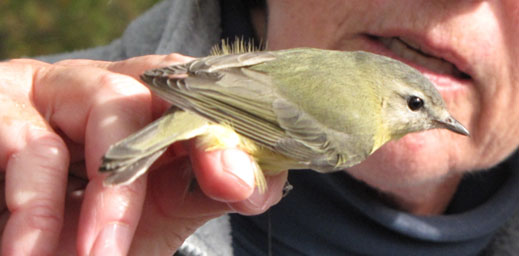
A Philadelphia Vireo banded at Barr Lake State Park. Photo by Emily Snode.
Throughout an eventful fall season, RMBO’s educators and volunteer naturalists had the opportunity to share our excitement at the banding station with nearly 1,400 students and more than 200 adults. Participants were able to look over the shoulder of a real scientist and see the entire banding process. Students also discovered that it was tough being a migrating bird, as about 50% of them were unable to make it through our migration obstacle course. This statistic is quite close to the real number of songbirds attempting their migration journey for the first time.
During the season, we had several high school students visit as part of the Experience 9 to 5 Program with Adams County Education Consortium. Our first ever attempt at banding in the evening proved to be well worth it, as we caught our first of three White-throated Sparrows of the season.
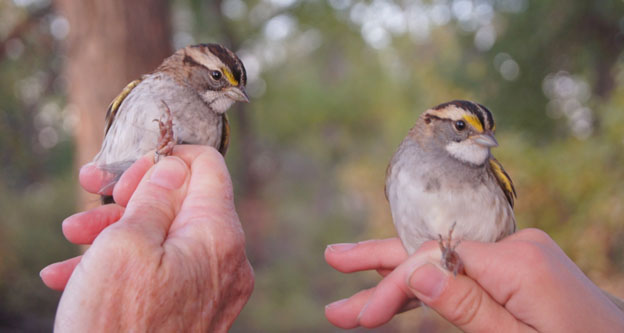
White-throated Sparrows looking sweet. These are two of the three individuals of this species banded at Barr Lake this year. In the preceding seven years, we have caught a total of six White-throated Sparrows. Photo by Jordan Spalding.

A bird bander in training. RMBO’s bird bander Meredith McBurney is seen here teaching an Experience 9 to 5 participant, Maria Bustos, the proper photographer’s hold with a male House Finch. Maria had an amazing experience at Barr Lake and wants to build on this experience by pursuing a career with animals. Photo by Emily Snode.
Along with a few new species, we had another first at the Barr Lake Banding Station – a live broadcast! Using video conferencing equipment connected to a 1-meter satellite dish, the Denver Museum of Nature & Science broadcast the banding station to hundreds of students in classrooms across the U.S. as part of its Scientists in Action distance learning program. Meredith did a fabulous job demonstrating how and why we band birds, while Andrew Doll, an ornithologist with DMNS, showed how bird collections are used to forward science and research. The students peppered the scientists with questions: “How many birds are there in the world? Why do birds migrate? Why do birds have different bills?” Meredith and Andrew ended each session reminding kids that birds are all around us, so get outdoors and enjoy them!
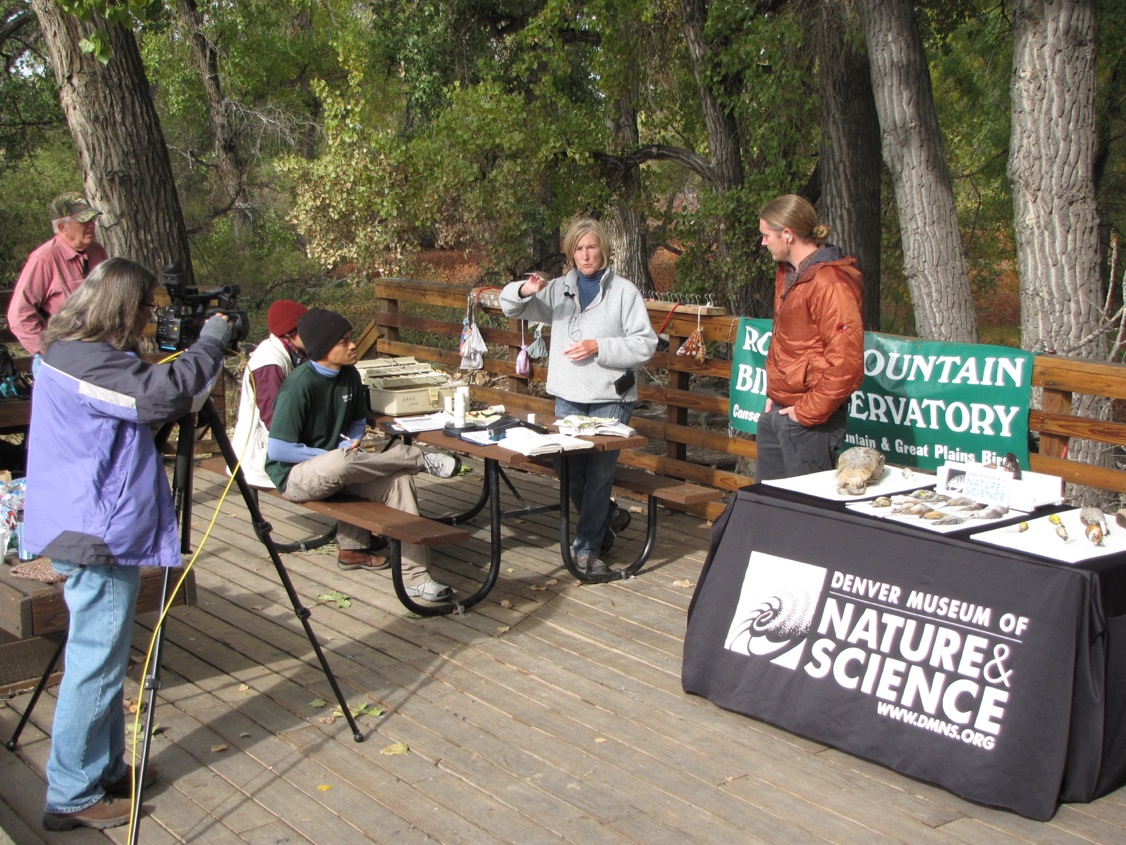
Live from the Barr Lake Banding Station! The Denver Museum of Nature & Science broadcasts the station to students across the U.S. as part of its Scientists in Action distance learning program.
Many of these students would have been unable to participate if not for the wonderful support of Ed Warner, Norris Family Foundation, Morgridge Family Foundation, Adams County Open Space, Scientific & Cultural Facilities District and New Belgium Brewery, who provided funding to help cover program fees and bus transportation. Many thanks also go out to our volunteers and Barr Lake State Park for helping make our fall banding season possible.
As the field trips have ended and the station is now closed, it is time for RMBO educators to gear up and bring our programs into the classroom. If your organization or school is in the Denver Metro area and interested in any of our in-class programs, please contact Emily Snode at [email protected] or 303-659-4348 ext. 11.
~ Emily Snode, School Programs Coordinator


